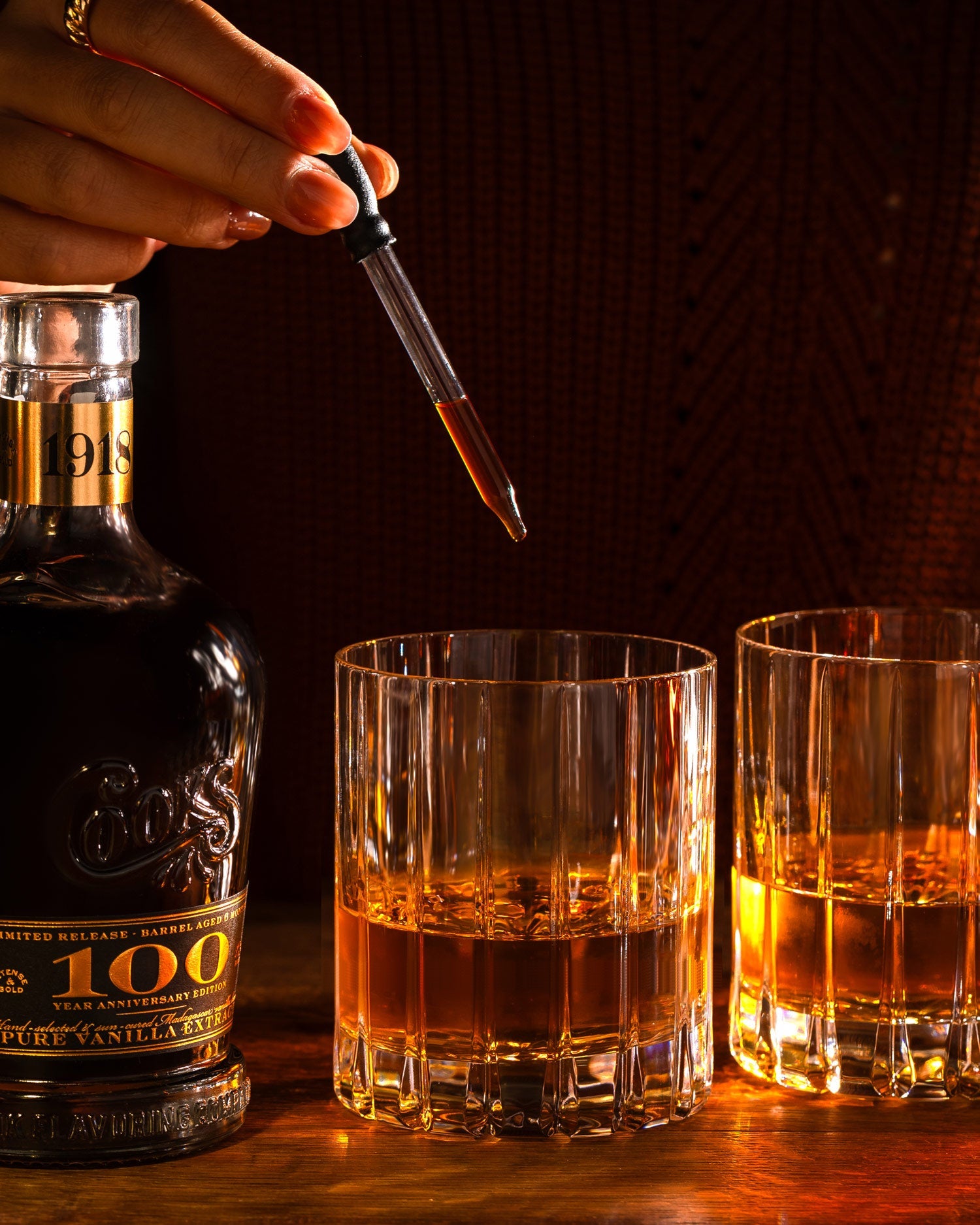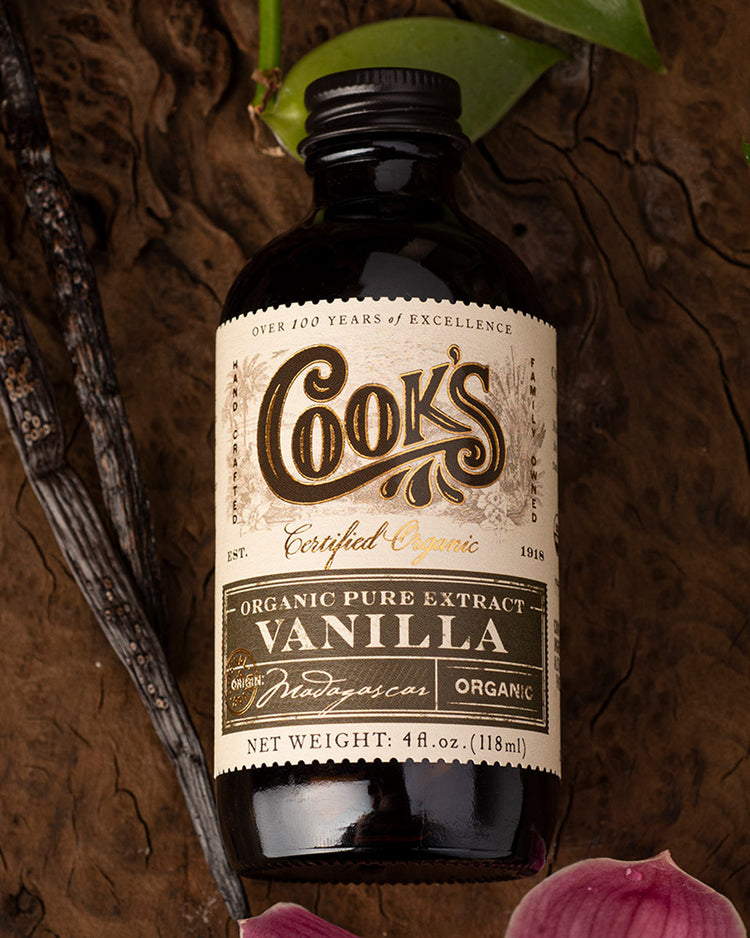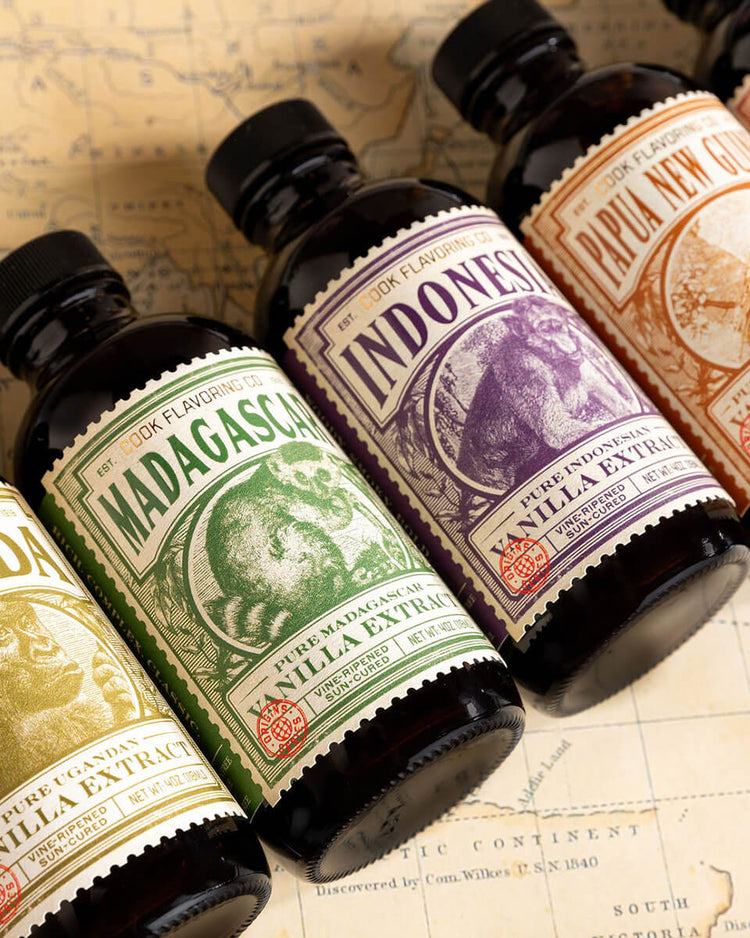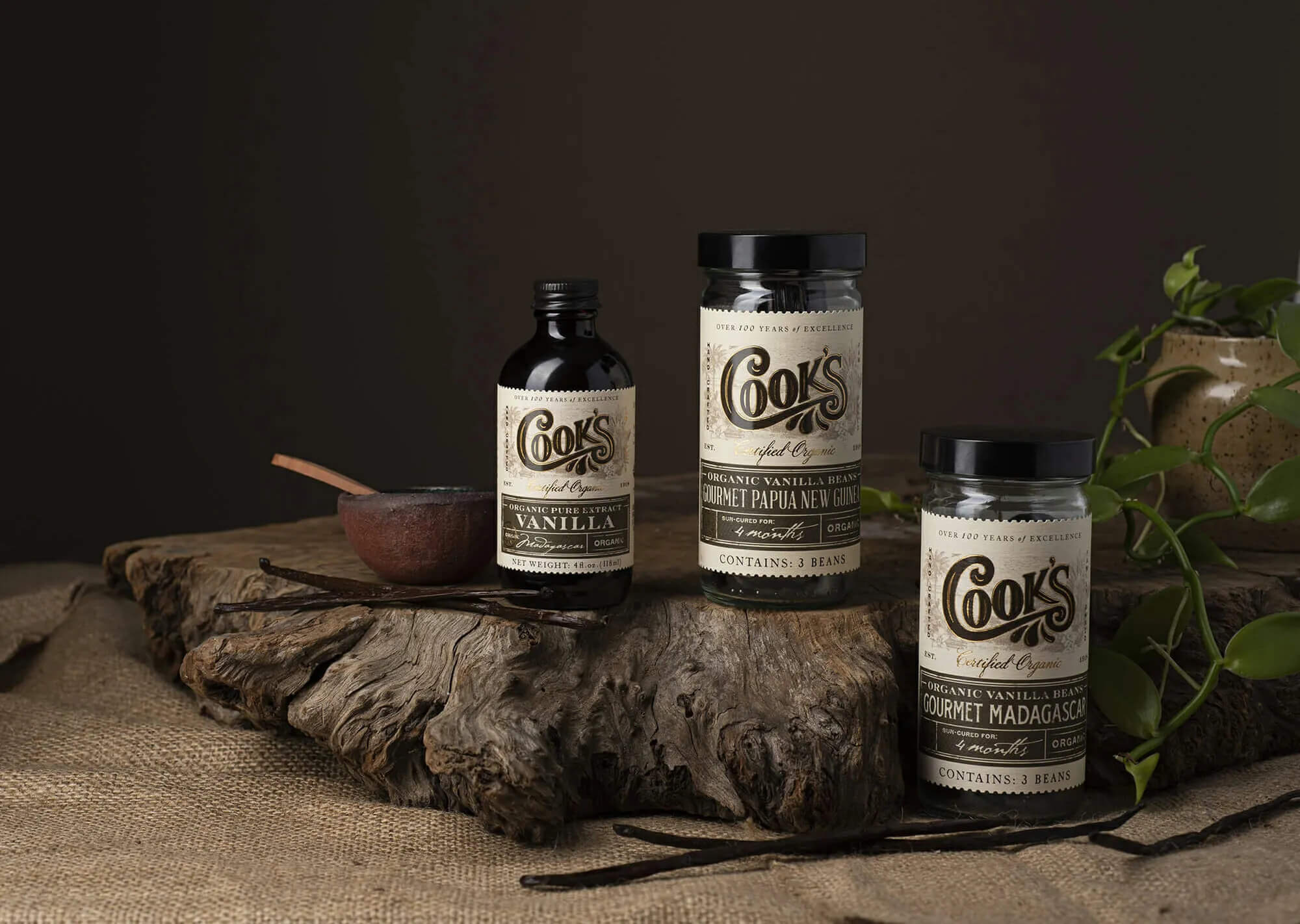Extraction is a relatively simple scientific process. Essentially, solids can be mixed into a liquid, mixed, and some characteristics of the solid will be absorbed into the liquid. The intensity and quality of the extraction can be changed by choosing an optimal liquid, changing the temperature or pressure, increasing the surface area of the solid, mixing, and increasing the time of the extraction.
A great household example is coffee. Coffee beans can be extracted into water to produce a delicious beverage. We will go through each of the variables in extraction to demonstrate the changes.
1. Optimizing the Liquid
Most coffee is made by extracting the beans into water. However, this is actually not the most optimal liquid for flavor extraction. A better liquid, similarly in the case of vanilla beans, would be an alcohol-water mix. An alcoholic extraction of coffee beans would yield a more intense coffee flavor, however, in terms of caffeine, water is a good liquid for extraction. So, depending on which characteristics of the coffee bean you wish to optimize, you can change the composition of the extraction liquid. (From a chemical perspective, like dissolves like. This is usually demonstrated with oil and water, but it applies to liquids and solids too. A good household example would be that sugar dissolves well into water, but protein powder is much more difficult to dissolve into water and usually requires vigorous shaking. This is because molecularly, sugar is more similar to water than protein powder is.)
2. Changing the Temperature or Pressure
There is a reason that most coffee is extracted by hot water- it works better in a shorter amount of time. Hot water increases the solubility so effectively, that hot coffee can be made by simply pouring boiling water over coffee beans and the extract can be ready in minutes or even seconds.
Cold water is used to extract coffee beans into water as well. Thus, enter the trend of cold brew coffee. Cold brew coffee is often very strongly caffeinated and takes a few hours or a day to make. The longer amount of time allows for maximum extraction of caffeine(which likes water) and a very good extraction of flavor.
Finally, pressure is used to make espresso. The water is passed through the intense heat and pressure of the head of the machine and the result is a very strong coffee extraction. You may have noticed, however, that especially compared to cold brew, but also to pour over or French press coffee, there are less fruity, spicy, or chocolatey notes in a shot of espresso. This is because those more delicate flavors are actually destroyed by the high heat and temperature of the espresso machine.
(From a chemical perspective, all molecules are moving all of the time, even solids. They are moving as a unit, but also the individual atoms are moving, or vibrating. When you mix a solid and liquid together, the molecules bump into each other and, if they "like" each other enough, the solid will dissolve into the liquid. All molecules move faster when they are hotter, thus increasing the number of bumps, or collisions, over time. Similarly, when there is higher pressure, the molecules are closer together and more collisions also take place. The vibration between the atoms also increases with an increase in temperature and pressure. Thus delicate molecules can literally be ripped apart by vibration or crushed by collisions. Once these molecules are destroyed, they cannot be repaired. Flavor components are particularly delicate and thus extremely susceptible to being crushed or ripped apart by violent collisions induced by high temperature and pressure.)
3. Increasing the Surface Area of the Solid
This sounds complicated but is actually very simple. With coffee, this principle is demonstrated with the size of the grind. A fine coffee bean grind will produce a stronger flavor, while a coarse grind, or no grind at all, will produce a much weaker extraction.
4. Mixing
Mixing the extraction liquid while the solids are still in it essentially increases the number of collisions physically, rather than chemically. An increase in physical collisions is much more gentle on the molecules than an increase in chemical collisions caused by temperature and pressure. Mixing can vary in vigorousness from gentle, as with a spoon, to intense, as with a blender.
Coffee is usually only mixed in a French press technique to ensure that all of the grounds come in contact with the water and is done so gently, usually with a spoon. The cold brew coffee often has a more intense and complicated flavor because of the generous amount of time given for the extraction process. Time is by far the most gentle way to increase the strength of the extraction.
Extraction Principles for Vanilla Extract
Now, how can these principles be applied to vanilla beans and vanilla extract both industrially and at home?
1. Optimizing the Liquid
Vanilla extract has a standard of identity set forth by the FDA. The FDA requires at least 35% alcohol by volume for a pure vanilla extract. At Cook’s, we have found that a mixture closer to 50% alcohol and 50% water is much more ideal.
Industrially, most pure vanilla extracts are made from concentrate. This means that the concentrate is blended with a solution of 35% alcohol and 65% water to achieve the required standard. The concentrate may be achieved by a variety of liquids that are completely evaporated after the concentration is complete. These liquids are often inedible but very efficient at extraction.
At home, we recommend using high-quality vodka between 80 and 100 proof for your homemade vanilla extract.
2. Changing the Temperature or Pressure
At Cook’s, we stand by the traditional cold press extraction method. This means that our vanilla extract is made by a long, two-week extraction in ambient temperature and pressure. We maintain that this method of extraction, while much less efficient, produces the highest quality vanilla extract.
Most vanilla extracts on the market are manufactured using the “industrial” method. This involves mixing the vanilla beans with a highly efficient extraction liquid, often inedible, and subjecting the mixture to high temperature and pressure. This process usually only takes a few hours. The result is a viscous brown liquid that is then diluted back.
There are a few serious problems with this method. The first is that the vanilla beans used for this method must be extremely dry in order to keep the concentrated mixture from gumming up and interfering with the concentration process. Very dry vanilla beans have been cured usually improperly and are often lacking in vanilla flavor while possibly having some moldy flavor characteristics.
The second main problem is that, as we discussed with the coffee beans, subjecting vanilla beans to high temperatures and pressures destroys the complex and delicate flavor profile of excellent vanilla beans. The result, even if excellent beans are used, is a flat and sometimes cooked flavor profile. In fact, the reason that vanilla extract is usually bottled in amber bottles and recommended to be kept in a cool, dark place is that even exposure to the sun’s heat and energy can destroy these delicate flavor molecules. The amount of heat and energy transferred by keeping your bottle of extract in the sun, even over a long period of time, pales in comparison to the intense heat and energy supplied by industrial concentrating machines.
Now how can you optimize heat and temperature at home for your homemade vanilla extract? Well, we simply recommend that you don’t. This is where the new trends of sous vide and pressure cookers come into play.
Sous vide machines will maintain a higher temperature over a period of time not usually exceeding 12 hours. While this is certainly the gentler of the two trends, we still recommend against making homemade vanilla extract with any heat. If you are taking the time to make homemade vanilla extract, you are likely desirous to achieve a high-quality vanilla extract. This desire will be foiled by even the gentle heat of the sous vide machine.
Pressure cookers will add heat and pressure to the homemade vanilla extract. While you can probably achieve some kind of vanilla extract in 2-3 hours using an at-home pressure cooker, we strongly recommend against this method. This will inevitably destroy many of the delicate vanilla flavor molecules in your carefully selected vanilla beans. It would be much preferable to either use the whole vanilla beans in your baking or to purchase a high-quality vanilla extract from a trusted company.
3. Increasing the Surface Area of the Solid
This is a basic principle that is employed by all extractors and one which we recommend replicating at home. We recommend that you cut the vanilla beans up into about ¼ inch pieces before putting them into the vodka. At a minimum, we recommend that you slice the vanilla beans in half length-wise so that the middle of the vanilla bean pod, filled with seeds and oils, will be exposed to the alcohol and water mixture.
4. Mixing
At Cook’s, we do employ mixing in the form of percolation. Our percolators gently circulate the water and alcohol through the vanilla beans over several weeks. This gentle mixing is akin to mixing with a spoon or gently shaking a bottle. It aids in the extraction process while maintaining the flavor integrity of the extraction.
At home, we recommend that you gently shake your homemade vanilla extract every time you see it in the cupboard. It is impossible to achieve the same quality extraction at home that we achieve at Cook’s. For evidence of this, see this blog. Even after years of using the higher than recommended vanilla bean to alcohol ratio, the resulting homemade vanilla extract is much lighter in color and less fragrant. See image below. This is because we have perfected the process over 100 years and utilize the best equipment and extraction principles. Nevertheless, you can certainly achieve a good homemade vanilla extract and help the extraction along by frequently shaking the bottle.
4. Time
The tradeoff for utilizing the cold extraction method is that it takes a lot of time. Industrial concentrates can be made in a few hours whereas our artisan vanilla extracts take several weeks. We think that this tradeoff more than pays off in the quality of the resulting vanilla extract.
At home, time is even more important. For homemade vanilla extract, we recommend a minimum of two months to achieve a good extraction. Vanilla beans should never be removed from the alcohol and water until all of the liquid is used. (You can also add the previous batch of extracted vanilla beans to the new batch of homemade extract to continue the extraction process. Alternatively, you can add the extracted vanilla beans to your sugar jar. Even industrially extracted vanilla beans still retain flavor after the extraction is performed. Don’t waste that flavor!)
The Bottom Line for Homemade Vanilla Extract Using Sous Vide or Pressure Cookers?
Just don’t do it! Do not sacrifice the quality of your vanilla extract for a quick extraction! As mentioned before, if you are taking the time to make homemade vanilla extract, you likely strongly care about the quality of your vanilla extract and your vanilla beans. You have probably painstakingly sought out a reputable supplier for excellent vanilla beans. To sacrifice the quality of your vanilla beans would be taking two steps back. Ultimately pressure cookers and sous vide machines are designed to cook food. Vanilla beans should never be cooked, whether over a fire during an improper curing process, in an industrial concentrator, or in a pressure cooker or sous vide machine at home.
-
Posted by Suzanne York on
Hmmm. One question- as vanilla is native to tropical climates , the live plant is okay up to 95f, and the curing and drying process of the pods is routinely done between 115-150f…traditionally in the sun…..so it seems unlikely that exposure to temperatures under 150 would do anything to damage its volatile oils … not a food scientist, but seems logical.
-
Posted by Rachel on
I just want to commend the author! What a beautifully written and informative article. Your tips are very clear and actionable, and the reasoning is easy to follow and based on science. I found this article through a Google search and it’s my first experience with this company, but it left such a good impression that I’m going to check out the shop. Great job.








Comments ( 2 )